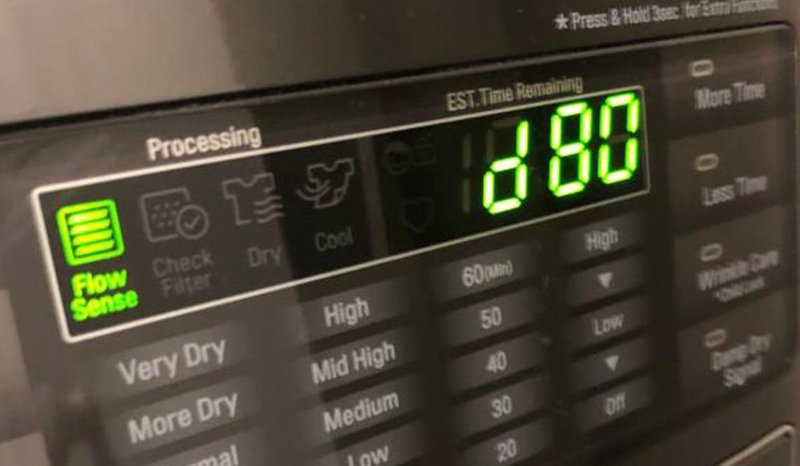
Sometimes, our modern gadgets can feel like they’re speaking a different language with these codes. However, understanding that the F2 code usually relates to a temperature sensor issue can demystify things a bit. Imagine the sensor as a thermostat in your dryer, keeping tabs on the heat to ensure your clothes are drying safely and efficiently. When that little helper experiences issues, it can’t regulate temperature properly, which prompts the F2 error. Let’s explore when it’s time to bring in the pros for this dryer dilemma.
Understanding the LG Dryer F2 Error Code
When your LG dryer flashes the F2 error code, it refers to a problem with its temperature sensor, which is vital for proper drying cycles. This sensor functions much like your thermostat at home; it monitors and regulates the heat inside the drum. If the sensor isn’t working as it should, it can throw off the entire drying process, which is why your dryer flags this with an F2 code. Think of it as the dryer’s way of saying, “Hey, I can’t keep track of the temperature anymore. I need a check-up!”
What causes this sensor to trip and flash the F2 error? Well, it could be due to aging or wear and tear that affects electrical connections. Just like any other electronic device, repeated use can lead to failures or disruptions. Imagine an old pair of sneakers. Initially, they fit perfectly, but over time, they wear down and lose their shape. In a similar way, frequent usage can affect the efficiency of the dryer’s sensor.
Moreover, environmental factors like dust or debris can interfere with the sensor’s readings. Dust bunnies might be harmless under your sofa, but in a sensitive gadget like a dryer, they can cause significant hiccups. Therefore, regular cleaning and maintaining a dust-free dryer environment can prevent such issues from escalating. So, next time your dryer displays an F2, consider these potential underlying causes.
DIY Fixes Before Calling a Technician
Before you ring up the experts, there are a few troubleshoot steps you might want to try. First and foremost, make sure your dryer is turned off and unplugged—safety first, always! Once that’s settled, you can inspect the area around the lint filter. Removing lint buildup might sound basic, but it’s surprising how often this simple step alleviates performance problems.
After clearing out the lint, give the dryer drum a gentle rotation by hand to see if it moves freely. Sometimes, physical obstructions can mimic sensor issues. Plus, while you’re at it, inspect the back of your dryer for any obvious signs of wear or loose connections. You know, kind of like the way you’d check a garden hose for kinks that block water flow.
If you’re feeling a bit more adventurous, you can also check the wiring connected to the temperature sensor for any visible damage. Remember, this might be a bit advanced for some, so don’t feel pressured. If these initial steps don’t resolve the issue, it might be time to call in professional help. They come equipped with the tools and know-how to dig deeper into the problem.
When It’s Time to Call a Technician
So, when should you stand aside and let the pros handle it? If your initial DIY attempts didn’t pan out, or if you’re not comfortable diving into the guts of your dryer, it’s time to call a technician. Skilled technicians have special tools and training to accurately diagnose and fix the specific issues causing the F2 error. It’s like bringing your car to a mechanic for a tune-up; they have the expertise to ensure everything runs smoothly again.
Another scenario where calling a technician is a must is when you notice recurring F2 errors despite following maintenance tips. This pattern of errors suggests there might be a deeper or more significant problem lurking beneath the surface. Things like faulty circuit boards or broken heating elements are best left to the experts who can safely replace or repair them.
Also, if your dryer is still under warranty, it’s smart to let authorized technicians handle any repairs. This way, you won’t risk voiding your warranty by attempting fixes yourself. Ultimately, peace of mind is invaluable, and knowing a skilled professional is addressing your dryer issues is worth every penny.
Preventative Maintenance Tips
Taking preventative measures means fewer surprises and smoother sailing with your LG dryer. Consider setting a regular cleaning schedule, focusing on both the lint filter and the dryer drum. Much like how routine check-ups can keep our health in check, consistent cleaning helps prevent malfunctions and prolongs the lifespan of the appliance.
It’s also wise to keep the area around your dryer clear of dust and debris. Think of this as creating an optimal environment for it to work efficiently, akin to ensuring proper ventilation in a kitchen when cooking. Additionally, perhaps once a year, you might engage a professional for a comprehensive check-up. This proactive approach catches small issues before they become significant problems.
Regularly reviewing your dryer’s manual to understand its needs and requirements can be incredibly beneficial too. Remember, a little attention here and there can help avoid those pesky error codes. It’s all about getting ahead of the game and enjoying the full benefits of your dryer without the headaches of unexpected breakdowns.